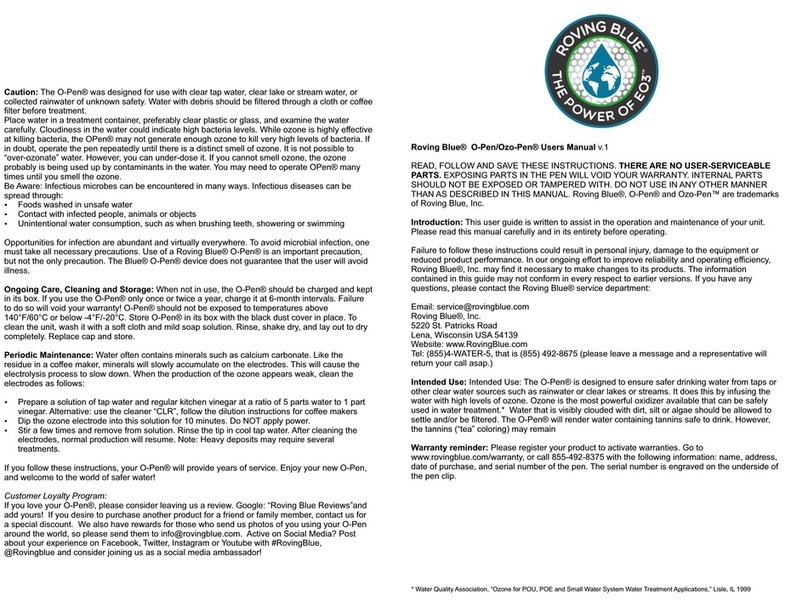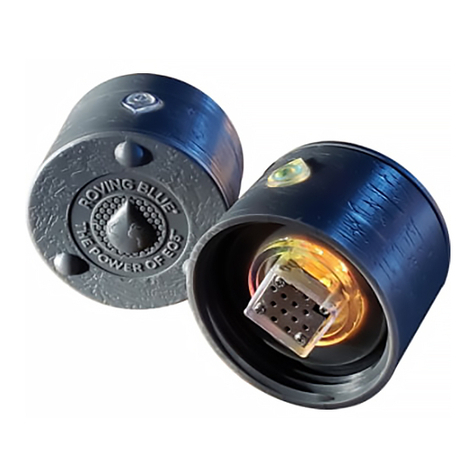Overview: The Roving Blue® O-Pen™ makes water safe to drink by using dissolved
ozone as a sanitation agent. Ozone, or “O3”, is the most powerful oxidizer available that
can be safely used in water treatment. Ozone is a strong oxidant that is widely
recognized as a biocide and has the ability to achieve more than 99.9% pathogen kill
rates. Treatment with ozone is a proven and long-accepted method for disinfecting
drinking water. Users of ozone technology include municipal water treatment plants,
water boiling companies, hospitals and hotels.
In 1997, the FDA approved the use of ozone as an anti-microbial agent with
indirect contact with foods.
In 2002, the FDA approved ozone for use on food contact areas and directly on food
with its “Generally Regarded as Safe” (GRAS) designation. Today, the Organic Foods
Production Act (OFPA) identifies aqueous ozone (ozone dissolved in water) as a
substance that is allowed for use in organic crop and livestock production.
Ozone has been shown to be effective in a variety of drinking water applications
including: Disinfection, iron (Fe) and manganese (Mn) reduction, hydrogen sulfide
removal and taste and odor reduction.
Ozone can also reduce formation of disinfection by-products such as trihalomethanes
(THMs) and halo acetic acids (HAAs). Ozonation is effective for removal of difficult to
treat pathogens such as giardia and cryptosporidium. The amount of O3 generated by
the O-Pen™ will vary depending on water temperature, chemistry, conductivity and pH.
Before Your First Use: Your unit comes equipped with lithium ion rechargeable batteries.
Prior to use, you will want to fully charge the O-Pen™. Remove the clear silicone cap (A)
from the end of the pen. Plug the USB charger cord mini plug (B) into the plug port
socket (C). Then, Insert the USB plug (D) into any 5V USB power supply to charge.
To show that the unit is charging, a LED light (E) will illuminate. When fully charged,
the light will either dim or turn off, (depending on pen model) to indicate that the pen
is fully charged. Charging will take 5 minutes to 3 hours depending on charge state of
battery pack. When charging is complete, remove the power cord and replace the
clear silicone cap.
Remove the pen cap (F) by twisting it counter-clockwise. Place the O-Pen™ in a glass
of water so that the stainless metal electrodes are (G) are fully submerged.
Press the small ON/OFF button (H) on the end of the pen. Depending on your pen
model, a blue or green LED light will come on. Each pen is timed for a :40 second run
me “dose” (:30 is good for 8 oz, 1:00 is good for 16 oz.) . When the timed cycle is
complete, the LED light will go out. You may now swish the tip in the glass and repeat 5
times. This will ensure the electrodes are clean and clear of a protective coating.
Dispose of the water. Do not consume. Your unit is now ready to be used.
to disinfect the water. It is not harmful to consume the water at this point, however,
many people prefer to let the ozone go away completely before consuming. This will take
anywhere from 5 minutes to an hour depending on the water's temperature, pH, and
other factors. While you can still smell the ozone, that water can actively kill germs, so
you can use it to disinfect wounds, rinse your mouth (like a mouthwash), or to rinse
vegetables.
NOTE: If the water is very dirty or contains silt, it should be collected in a receptacle
(such as a jerry can or bucket) and allowed to settle prior to use, preferably overnight.
It is not possible to “over-ozonate” water, so if the water is still suspect, you may
repeat doses for additional peace of mind.
Shut Down Procedures:
Once you are done, remove the O-Pen™ from the water and give it a shake to remove
the excess water. Optional: Lay it out on a clean napkin or cloth to dry fully. Replace
the cap and store in its box. For further information and videos demonstrating these
procedures, you should contact your nearest Roving Blue® seller (see Map on our
website) or contact us directly at: www.RovingBlue.com.






















